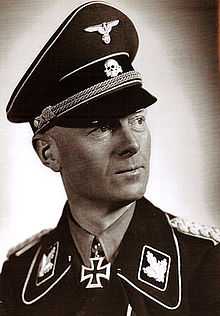Herbert-Ernst Vahl
| Herbert-Ernst Vahl | |
|---|---|
 Herbert-Ernst Vahl, official portrait after being awarded the Knight's Cross | |
| Born |
9 October 1896 Posen, Prussia |
| Died |
22 July 1944 (aged 47) near Thessaloniki, Greece |
| Allegiance |
|
| Service/branch |
|
| Years of service | 1914-1944 |
| Rank | SS-Brigadeführer und Generalmajor der Waffen-SS |
| Commands held |
|
| Battles/wars | |
| Awards | Knight's Cross of the Iron Cross |
Herbert Ernst Vahl was a Brigadeführer (Major General) and Generalmajor in the Waffen-SS during World War II. He was the commander of the 2nd SS Panzer Division Das Reich and the 4th SS Polizei Division, who was awarded the Knight's Cross of the Iron Cross, which was awarded to recognize extreme battlefield bravery or successful military leadership by Nazi Germany during World War II.[1]
Herbert Ernst Vahl, was born on 9 October 1896 at Posen, Prussian Province of Posen.[1]
World War I
During World War I he joined the 7th Infantry Regiment in 1914, being selected to become an officer on 8 January 1915. He served on the Western Front at the Somme and Verdun. He was twice wounded in 1916 and 1917 and by the end of World War I, had been awarded the Iron Cross 1st and 2nd class.[1]
Between the wars
At the end of World War I, Vahl had decided to stay in the Army (Reichswehr). He served as an Instructor in several of the Military schools, before being posted to the 14rh Company, 16th Reiter Regiment (Cavalry) in Berlin.[1]
In November 1936 Vahl was promoted to Major and posted to the II.Battalion, 4th Panzer Regiment, 2nd Panzer Division.[1]
World War II
In September 1939 Vahl was promoted to Oberstleutnant (Lieutenant Colonel), and posted to command the 65th Panzer Battalion, 6th Panzer Division which he served with during the Polish Campaign.[1]
In May 1940 he was in command of the 101st Panzer Battalion, which was a special unit comprising only flamethrower tanks. He commanded this Battalion during the Battle of France, the invasion of the Balkans (Operation Marita) and the Invasion of Russia (Operation Barbarosa).[1] During this time he was awarded the German Cross in Gold and the Panzer Badge.[1]
Vahl's Battalion was then attached to the German 3rd Infantry Division (Motorised) and moved to the Leningrad sector of the front.[1]
On 13 December 1941 Vahl was promoted to Oberst (Colonel) and given command of the 29th Panzer Regiment, 12th Panzer Division.[1]
In 1942 under orders from Berlin Vahl left the Heer and joined the Waffen SS, and is given the rank of Standartenführer (Colonel), and posted to the Das Reich Division as the commander of the 2nd SS Panzer regiment.[1][2]
In February 1943, Vahl was promoted to Oberführer (Brigadier General), and given command of the Das Reich which was stationed in Russia. While in command during the Battle of Kharkov he was awarded the Knight's Cross of the Iron Cross and was seriously wounded at Bielgorod.[1][2]
In April 1943 while recovering from his wounds he was promoted to Brigadeführer (Major General) and Generalmajor of the Waffen SS. After recovering from his wounds he became the Inspector of Panzer troops in the SS Führungshauptamt (SS main office).[1][2]
In July 1944 Vahl returned to active service with the 4th SS Polizei Division which was in Greece serving in Thessalonika fighting against partisans.[1][2][3]
Vahl arrived to assume command of the Division on the 13 July 1944 but was killed in a motoring accident on the 22 July 1944.[1][2][3]
Summary of his military career
Dates of rank
- Leutnant: January 8, 1915
- Oberleutnant: April 1, 1925
- Rittmeister: February 1, 1931
- Major: November 1, 1936
- Oberstleutnant: February 1, 1939
- Oberst: December 13, 1941
- SS-Standartenführer: August 1, 1942
- SS-Oberführer: February 10, 1943
- SS-Brigadeführer und Generalmajor der Waffen-SS: April 1, 1943
Notable decorations
- Eastern Front Medal (1942)
- 1914 Iron Cross Second (1915) and First (1918) Classes
- Clasp to the Iron Cross Second (1939) and First (1941) Classes
- Knight's Cross of the Iron Cross (1943)
- Wound Badge in Black (?) and Silver (?)
- Honour Cross of the World War 1914/1918 (1934)
- German Cross in Gold (1941)
- Panzer Badge in Silver (?)
Notes
- Vahl was not member of the NSDAP.
- His SS # was 430 348 and he joined the SS on August 1, 1942.
References
- Gordon Williamson - The SS: Hitler's Instrument of Terror: The Full Story From Street Fighters to the Waffen-SS - Motorbooks International, (March 1994), ISBN 0-87938-905-2, ISBN 978-0-87938-905-5.
- Yerger, Mark C. - Waffen-SS Commanders: The Army, Corps and Divisional Leaders of a Legend : Kruger to Zimmermann - Atglen, PA: Schiffer Publishing (1999). ISBN 0-7643-0769-X, ISBN 978-0-7643-0769-0
| Military offices | ||
|---|---|---|
| Preceded by SS-Obergruppenführer Georg Keppler |
Commander of 2. SS-Division Das Reich February 10, 1943 - March 18, 1943 |
Succeeded by SS-Oberführer Kurt Brasack |
| Preceded by SS-Oberführer Friedrich-Wilhelm Bock |
Commander of 4th SS Polizei Division May 7, 1944 - July 22, 1944 |
Succeeded by SS-Standartenführer Karl Schümers |